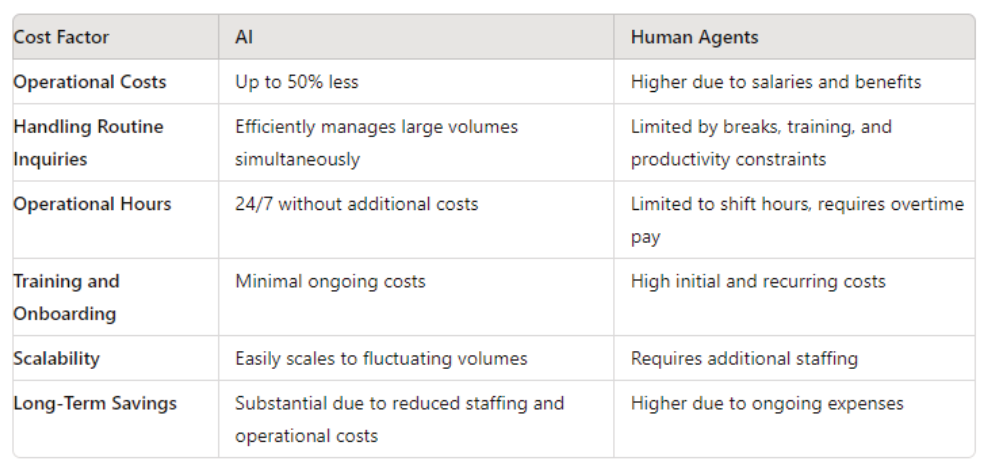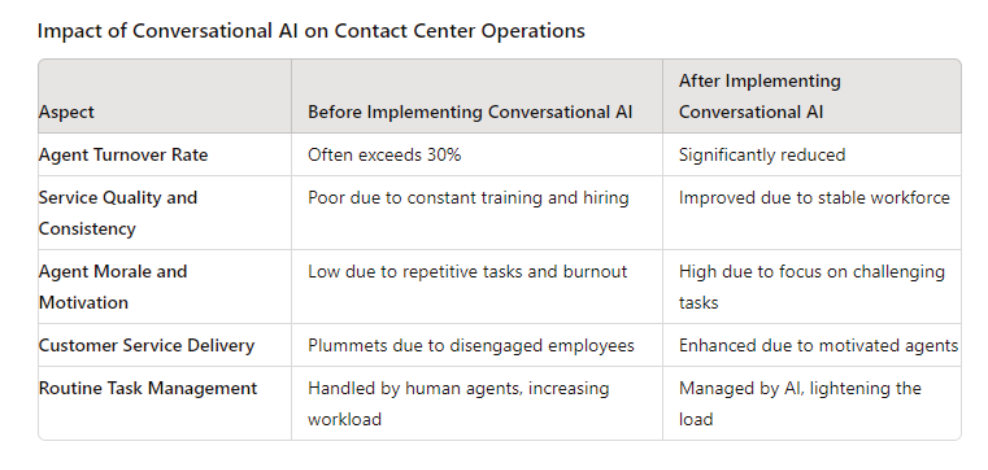Exceptional customer service is crucial in today’s competitive business environment. Metrics such as Customer Satisfaction (CSAT) and Customer Effort Score (CES) are vital in assessing a company’s performance in this regard. Yet, many businesses encounter difficulties in achieving high CSAT and CES scores through their contact centers. Businesses that adopt AI-powered customer service solutions typically experience a 67% rise in their CSAT scores. Discover how conversational AI can effectively address these challenges and transform customer service.
High Call Volumes
Conversational AI systems in contact centers, on average, have the ability to manage a much higher number of calls than human agents. Statistics show that AI-driven chatbots and virtual assistants can deal with numerous calls concurrently, resulting in a significant boost in call management capacity. For example, it is projected that AI can address around 80% of standard queries without the need for human involvement, whereas human agents are limited to handling one call per time. This increased efficiency enables AI systems to process up to five times more calls than human agents, delivering quicker and more uniform customer service.

Insufficient Staffing
Several contact centers function with a shortage of staff, which may not be sufficient to manage the high volume of customer inquiries, particularly during peak times. Conversational AI can serve as the initial support point, handling common inquiries and guaranteeing that customers get prompt assistance, irrespective of the number of employees available.
Service Inconsistency
Agents often deliver inconsistent service, leading to unpredictable customer experiences. In stark contrast, Conversational AI provides precise, reliable information every single time, ensuring dependable service regardless of the query or time of day. The lack of standardized processes and guidelines means agents can handle similar issues differently, further contributing to erratic service quality. Conversational AI, however, follows strict protocols and best practices, guaranteeing a uniform and high-quality approach to customer service.
Limited First-Call Resolution
Complex Issues
Certain customer problems are inherently complex and often require multiple interactions to resolve. However, leveraging Conversational AI can empower agents with instant recommendations and immediate access to extensive knowledge bases, drastically increasing the likelihood of resolving issues on the first call.
Agents often lack the necessary information or skills to solve problems on the initial call. Conversational AI can bridge these knowledge gaps by rapidly accessing vast data and delivering precise solutions, slashing the need for transfers and escalations.
Poor Use of Technology
Despite the prevalence of outdated technology in many contact centers, they often lack the efficiency and functionality required to effectively meet modern customer service demands. By integrating conversational AI, contact centers can be modernized with enhanced capabilities that enhance efficiency and customer experience.
Integration
When different systems and platforms are not integrated, it can result in fragmented service experiences, causing agents to lack a comprehensive understanding of the customer’s history and ongoing issues. Conversational AI offers seamless integration with current systems, delivering a cohesive perspective on customer interactions.
Inadequate Training and Support for Agents
Agents might not be sufficiently trained to effectively address a variety of issues. With 40% of agents reporting that inadequate training impacts their ability to resolve customer concerns, conversational AI can aid agents by offering immediate support and access to resources, guaranteeing they possess the necessary information to efficiently resolve customer concerns. Agents may face challenges in finding prompt solutions without immediate support and resources, leading to increased customer effort. Conversational AI provides real-time assistance, enabling agents to deliver quicker and more precise answers.

Ineffective Communication Channels
Providing solely traditional phone support may restrict customer satisfaction. Contemporary customers anticipate a variety of channels including chat, email, social media, and self-service alternatives. Conversational AI can be utilized on different platforms to deliver a uniform and effective customer experience. Despite the availability of multiple channels, they are frequently not properly integrated, resulting in inconsistent and disjointed customer experiences. Conversational AI guarantees smooth integration across channels, ensuring a coherent customer journey.
Rampant Agent Turnover
Constantly hiring and training new agents due to rampant turnover in contact centers wreaks havoc on service quality and consistency. With turnover rates often exceeding 30%, conversational AI can eliminate this chaos by taking over routine tasks, lightening the load on human agents, boosting their satisfaction, and slashing turnover rates. When agents are demoralized and unmotivated, service delivery plummets, as disengaged employees are unlikely to provide top-notch service. By offloading repetitive tasks to AI, agents can focus on more challenging and rewarding responsibilities, dramatically improving their morale and motivation.
Inadequate Feedback Mechanisms
If businesses lack robust methods for collecting and analyzing customer feedback, they risk missing crucial insights into customer pain points and opportunities for improvement. Conversational AI can automatically gather and analyze feedback from customer interactions, providing essential insights to drive continuous improvement.
However, businesses often drag their feet on acting upon feedback, allowing persistent issues to erode CSAT and CES scores. With 60% of customers reporting delays in response times, swift action is imperative. Conversational AI can accelerate feedback responses by identifying trends and recommending actionable improvements before problems escalate.
Difficulty in Measuring and Tracking Metrics
Measuring CSAT and CES accurately can pose a challenge, particularly when businesses lack the necessary tools and methodologies. Conversational AI enables real-time tracking and analysis of customer interactions, offering in-depth metrics and valuable insights on customer satisfaction and effort.
Superior Pricing
Implementing AI in a contact center can significantly reduce operational costs, with studies showing that AI solutions can cost up to 50% less than employing human agents. This cost efficiency arises from AI’s ability to handle large volumes of routine inquiries simultaneously without the need for breaks, benefits, or training. Unlike human agents, AI can operate 24/7, ensuring continuous customer support while eliminating expenses associated with overtime and shift differentials. Furthermore, the scalability of AI allows businesses to manage fluctuating call volumes without the need for additional staffing, resulting in substantial long-term savings and a more streamlined budget.

Conclusion
Businesses can leverage conversational AI as a robust solution to address the substantial obstacles encountered in achieving high CSAT and CES in contact centers. Through minimizing wait times, maintaining service quality consistency, boosting first-call resolution rates, updating technology, and assisting agents, conversational AI has the potential to revolutionize customer service. Moreover, by delivering seamless omni-channel experiences, decreasing agent turnover, enhancing feedback processes, and offering precise metrics, companies can elevate customer satisfaction levels and lower customer effort. As customer demands evolve, integrating conversational AI is crucial for remaining competitive and providing outstanding service.


